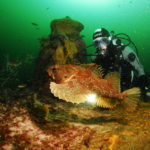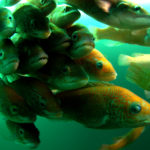It’s a contrary kind of morning on Chedabucto Bay. The sun is shining, but it’s cold and there’s a brisk wind blowing from the southwest; it’s churned up the waters here, between Cape Breton Island and Nova Scotia. We’re pounding through 4- to 6-foot swells in a 25-foot (8 m) rigid hull inflatable boat (RIB), heading out to dive one of the premier wrecks on the east coast of Canada — the SS Arrow. The ride out to the dive site is turning out to be a bone-jarring experience. All this for dive that still has huge question marks beside it in my mind.
First of all, given the state of sea, I’m not sure whether we’re going to be able to descend. Getting out of the boat isn’t going to be a problem — but crawling back into it when the boat is bobbing through a 10-foot arc is a real concern.
My other question: What will we find? When the Arrow went down on February 4th, 1970, it was an environmental disaster of massive proportions, one that — at the time — rivaled the Deepwater Horizon disaster of 2010. The ship was hauling 108,000 barrels of Bunker C fuel. It was old and lacked proper navigational instruments and, as a result, it struck Cerberus Rock at 9:30 a.m. and ran aground. Initially it wasn’t a disaster; the ship’s hull held firm. Attempts were made to haul it off the rock, but before the work could be completed, bad weather hit the coast and it split in two. The resulting oil spill contaminated 190 miles of coastline and ruined the local fishery. Eventually, a salvage vessel managed to extract some of the oil from the hold of the ship, but the question still remains — will I find a thriving artificial reef, or a still-leaking environmental killer?




As we approach the reef where the Arrow struck, the seas flatten out — marginally. Ingo Vollmer, owner of Vipi Lodge and Dive Shop, decides we’re good to go and we’re over the side and dropping down the descent line. My dive buddy is Ingo’s wife Anita, who decides we’ll do a circuit around the superstructure and top deck. The rough weather has churned up the seas and the visibility is poor, but we’re only at 50 feet (15 m), so the light penetration is excellent. Masses of shaggy seaweed cover the gangways of the superstructure, and thousands of small baitfish, a kind of ocean perch called cunners, swarm the top of the wreck. As we work our way down the length of the main deck, Anita points out a wonderful macro feature — the pipes and machinery that used to move the oil are covered in miniature, orchid-like sea anemones. As I approach, some of the pipes they look as if they’re covered with frosty clouds of cotton candy. We hit the far end of the wreck and I notice a couple of very promising swim-throughs — old hatchways that lead down to the forward hold and out the front of the wreck. I make a mental note to revisit them on the next dive with good visibility. We hit our turnaround time and head back for the boat, and I can’t help thinking there’s more to this wreck than I’m seeing under these conditions.
As we hit the surface, the dive gets a little tricky. The winds have picked up again, and the RIB is swinging wildly. There’s no dive ladder; instead, we have to catch hold of a rope and, while hanging on the side, remove our BCDs and weight belts, hand them up to the boat tender and then heave ourselves in. My arm and shoulder get severely yanked around and it takes some real work to hang on, but eventually I manage to get all my gear off and haul myself up over the side. I’m getting too old for this stuff, though I have to admit I feel a little like a Navy SEAL when it’s all over. Ingo asks me how the dive went. When I tell him, he says: “We’ll try again tomorrow.” He fires up the engine and we head for shore.
Diving the Arrow: Day Two
Day two begins on a promising note as I poke my head out of my cabin and see the sun shining. Even better, the wind has died completely. I head up to the dive shop and quickly pack my gear into the RIB. This time the journey out is magical. We blast along on a calm sea, past islands covered with sea birds. Eagles perch in the trees that line the bay. Every time I turn and look, a harbor seal is poking its head out of the water. In the distance, I see the back of a fin whale break the surface. Ingo tells me that sunfish (mola mola) often visit the bay in the summer. Suddenly Chedabucto Bay has come to life.




Our trip to wreck takes only a few minutes today, and we’re over the side of the RIB in record time. As soon as I submerge, I know the dive is going to pay off. I can see the top of the superstructure 50 feet (15 m) below me, and as I descend, I start to get a sense of the scale of the wreck. It’s massive, around 400 feet (122 m) long, 60 feet (18 m) wide and about 50 feet (15 m) high. We swim past the superstructure and head deeper to do a circuit of the main hull. Swimming 30 feet away from the wreck and parallel, I’m dwarfed by size of the structure. With such great visibility, I also start to notice a few other details — the bottom surrounding the ship is covered with scallops and lobster. We circle around to the front of the ship, where the bow of the Arrow tore away from the stern. Jagged and twisted plates and beams poke out from the hull, looking vaguely like a surreal, metallic space squid. There’s enough clearance to swim in for a quick look and I make a mental note to bring a reel or two the next time I come. When we pop back out and head for the main deck, I’m beginning to get a sense of just how alive this artificial reef has become. In the midst of the shaggy seaweed is an abundance of starfish, crabs and cod — it’s little wonder that harbor seals stop at this underwater smorgasbord regularly to feed.
Surrounded by such an abundance of life, it’s hard to picture the wreck as an environmental disaster of staggering proportions, but later Ingo tells me that inside the hull he still occasionally comes across globs of oil. Long before I’m ready to surface I’m out of bottom time. This time it’s an easy pull to get into the RIB and a gentle ride back to shore. I’ve finally gotten a good glimpse of this sunken oil tanker that I was so curious about. If there is any long-term damage in and around the Arrow, then I’ve certainly not seen anything to indicate it. From my brief visits I’m left only with the impression that, given time, the sea has an almost infinite capacity for resilience.
The post Diving the SS Arrow in Cape Breton appeared first on Scuba Diver Life.
from Scuba Diver Life http://ift.tt/25tYF8I